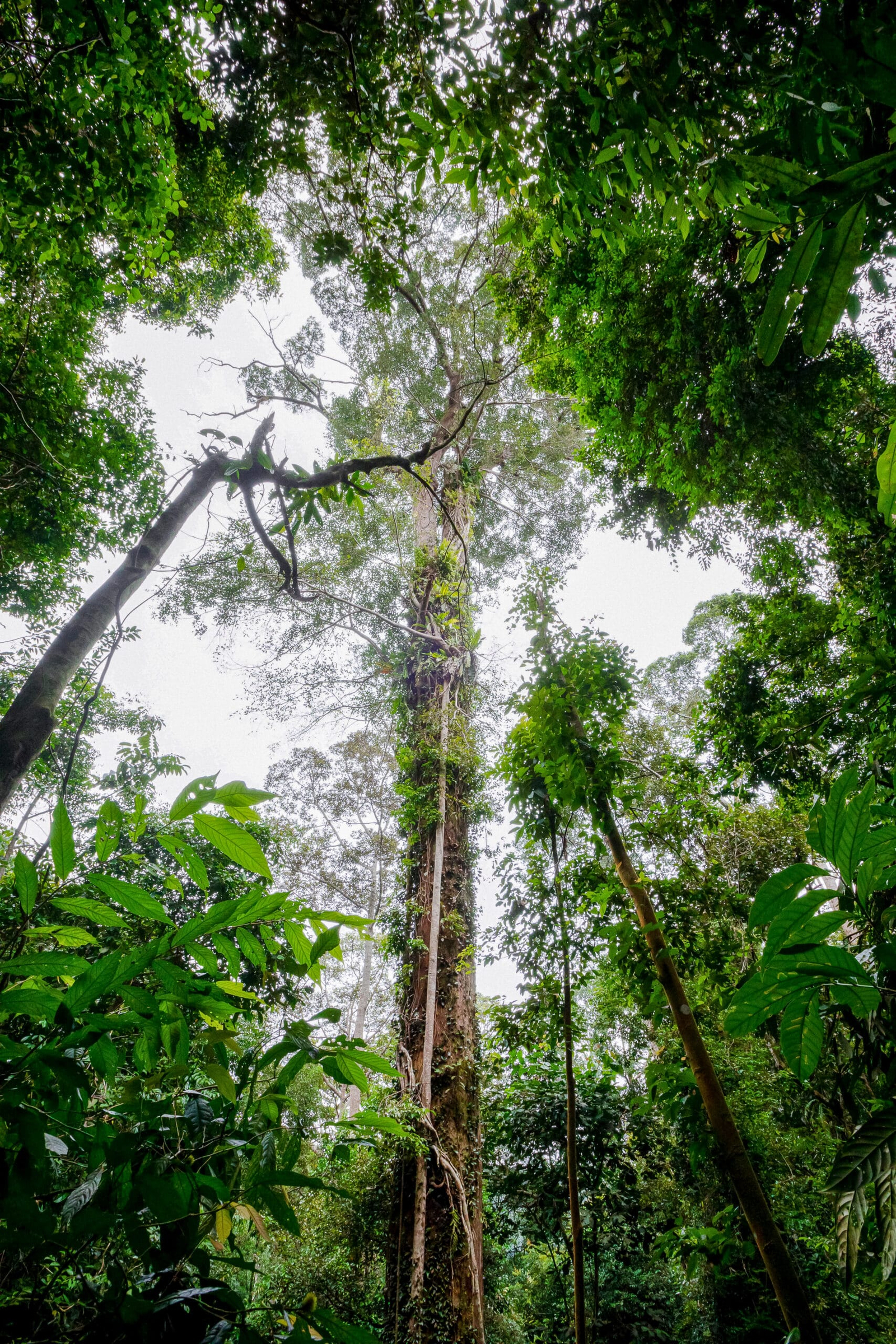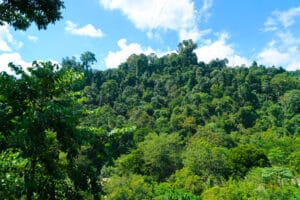Phone: +62 8527 0407 280 Email: info@bukitlawangtravel.com

Exploring Gunung Leuser National Park: One of Southeast Asia’s Largest Rainforest
Gunung Leuser National Park (TNGL) is one of Southeast Asia’s largest and most biodiverse tropical rainforests, known for its stunning natural beauty and incredible biodiversity. Spanning 10,946 km² across the provinces of North Sumatra and Aceh, this national park serves as a sanctuary for a wide range of endemic flora and fauna, including critically endangered species such as the Sumatran orangutan, Sumatran tiger, Sumatran elephant, Sumatran rhinoceros, and the giant rafflesia arnoldi flower.
What makes Gunung Leuser even more remarkable is its stunning landscapes and vital role as a conservation area to protect the fragile tropical rainforest ecosystem. It has also become a popular spot for eco-tourists seeking to explore the rainforests and witness wildlife in their natural habitats.
However, the park faces serious challenges beneath its natural charm, from deforestation to illegal poaching. This article will explore Gunung Leuser National Park’s natural wonders, unique biodiversity, tourist spots, and ecotourism activities.
A Brief History of Gunung Leuser National Park
Gunung Leuser National Park’s history began in 1927 when local communities and colonial authorities recognized the need to protect the unique biodiversity of the Alas Valley. Around the same time, a Dutch geologist named FC Van Heurn proposed that this area become a conservation zone, which led to the creation of what was then called the Leuser Natuurreservaat.
“Leuser Natuurreservaat” is a Dutch phrase that translates to “Leuser Nature Reserve.” “Leuser” comes from Mount Leuser, the second-highest mountain on Sumatra, standing at 3,445 meters above sea level. Fun fact—some say “Leuser” comes from the Gayo word Leusoh, which means “covered in clouds.” Others think it means “the last paradise for wildlife,” and honestly, both fit pretty well.
In 1928, another push was made to protect more areas, including southern Singkil, the stretch of the Bukit Barisan range, and the coastal swamps up north near Meulaboh. Fast-forward to February 6, 1934, and the Tapaktuan Declaration was signed. It was basically a pledge by local leaders to preserve the environment. The Dutch East Indies Governor also signed the declaration.
Not long after, on July 3, 1934, the Dutch East Indies established the Gunung Leuser Nature Reserve, covering 142,800 hectares. This decision followed numerous scientific expeditions that revealed the region’s exceptional biodiversity—where they found populations of Sumatran orangutans, tigers, and rhinos.
In 1935, the Dutch established the Kluet Wildlife Reserve, covering 20,000 hectares. After Indonesia gained independence, the conservation area expanded, incorporating additional zones such as Sikundur Recreation Park and the Kappi Wildlife Reserve. But it wasn’t until 1980 that Gunung Leuser was officially recognized as a national park. In 1997, Gunung Leuser National Park was formally designated with an area of 1.094.692 hectares, though sadly, its size has since shrunk—some reports now list it at around 830,000 to 792,675 hectares.
In 2003, Gunung Leuser National Park was awarded the status of ASEAN Heritage Park, recognizing its ecological value and extraordinary biodiversity within Southeast Asia. Then, just a year later, in 2004, the park received international recognition as a UNESCO World Heritage Site under the category of the Tropical Rainforest Heritage of Sumatra (TRHS), alongside Kerinci Seblat National Park and Bukit Barisan Selatan National Park. This recognition underscores Gunung Leuser’s critical role in preserving one of the last remaining tropical rainforest ecosystems in the world. Together, these parks form the Tropical Rainforest Heritage of Sumatra, often called the “Andes of Sumatra,” because it’s the largest conservation area in Southeast Asia.
The Enchanting Allure of Gunung Leuser National Park
Gunung Leuser National Park is renowned for its exceptional biodiversity and critical role as one of Southeast Asia’s largest conservation areas. Home to thousands of flora and fauna species, many of which are endemic and endangered, the park boasts a rich tapestry of life. What’s even more fascinating is the range of ecosystems you’ll find here—from dense tropical rainforests to towering mountains and even sprawling peat swamps. It’s a truly unique blend of nature that makes this park such an ecological treasure.
The Ecosystems of TNGL
Some of the significant ecosystems within TNGL include:
Tropical Rainforest:
Dense tropical rainforests cover the vast majority of TNGL. These rainforests are characterized by their thick canopy of towering trees, high humidity, and astonishing variety of flora and fauna.
The tropical rainforests in Gunung Leuser National Park are managed under a zoning system, allowing it to serve multiple purposes—from scientific research and education to cultivation, tourism, and recreation.
Mountain Forest:
As you climb higher into the park, the mountain forests take over, bringing a whole new atmosphere. Cooler temperatures, misty air, and high humidity create the perfect environment for plants that thrive in these unique conditions.
Peat Swamps:
Peat swamps in TNGL are nature’s climate regulators. Rich in carbon, these wetlands help balance water levels and prevent flooding. They also act as natural carbon sinks, storing vast amounts of carbon and helping combat climate change.
Rivers
TNGL’s rivers are lifelines for wildlife and local communities. Three major rivers—Agusen, Kala Tripa, and Tamiang—flow into the Malacca Strait and the Indian Ocean, providing clean water for countless species and people and irrigating nearby rice fields.
Subalpine Mountains:
Positioned at higher altitudes, the subalpine mountain ecosystems play a critical role in keeping ecological balance. These areas act as natural rain catchers. The water they retain slowly seeps into the soil, feeding rivers downstream and ensuring a steady water supply throughout the region.
A Wide Variety of Flora and Fauna
Gunung Leuser National Park is a botanical treasure trove, home to around 4,000 plant species. Among them are some of the world’s tallest trees, like the towering meranti and damar, and a stunning variety of orchids and medicinal plants. But the real showstoppers here are the iconic species, like the Rafflesia arnoldii and Rhizanthes zippelnii—the largest flower in the world, with blooms that can reach an incredible 1.5 meters in diameter!
When it comes to wildlife, Gunung Leuser National Park is truly special. It’s one of the few places in the world where you can spot four critically endangered species coexisting in their natural habitat, including:
Sumatran Orangutan: The Sumatran orangutan (Pongo abelii) is one of the largest primates in the world and is endemic to Sumatra. These arboreal creatures are characterized by their reddish-brown fur. The males have distinctive elongated cheek pads. They can grow up to 1.25 to 1.5 meters in length and weigh between 30 to 50 kilograms.
The habitat of orangutans is primarily lowland and montane rainforests, where towering Dipterocarpaceae trees create the perfect playground for swinging and climbing. You’ll often find them hanging out high in the canopy.
Sadly, Sumatran orangutans are now critically endangered, facing a severe risk of extinction in the wild, as noted by the International Union for Conservation of Nature (IUCN). Gunung Leuser National Park is one of only two remaining habitats for these unique primates, with just about 50 individuals left in the area. Their declining numbers are mainly due to deforestation and illegal hunting, which pose severe threats to their survival.
Sumatran Tiger: The Sumatran tiger (Panthera tigris sumatrae) is one of the most unique and rare tiger subspecies out there. These magnificent big cats are easily recognized by their striking coat, which feature a beautiful pattern of yellowish-brown fur adorned with bold black vertical stripes that extend from their heads to their tails. They can stand about 60 cm tall and reach up to 250 cm.
Unfortunately, the Sumatran tiger is facing a grave threat of extinction. Back in 2007, it was estimated that only about 192 of these magnificent tigers were left in the wild in Riau Province, and their numbers have continued to dwindle year after year. As of 2023, estimates suggest that there are now roughly 603 Sumatran still roaming the wild.
Sumatran Elephant: The Sumatran elephant is a fascinating creature, notably smaller than other Asian elephants. They typically weigh between 3 to 5 tons and stand about 2 to 3 meters tall. Their skin appears lighter than other Asian elephants, and you might even notice depigmentation on their ears, giving them a unique reddish-white flecked appearance. Sadly, the population of Sumatran elephants has declined due to illegal logging, habitat loss and fragmentation, and poaching.
Sumatran Rhinoceros: The Sumatran rhinoceros is the smallest rhinoceros species, typically reaching a height of 112-145 cm at the shoulder and weighing between 500 kg and 1 ton. Unfortunately, this species is critically endangered. The World Wildlife Fund (WWF) estimates that fewer than 80 Sumatran rhinos are left in the wild, surviving in small and fragmented populations.
Beyond the four iconic species we’ve discussed, Taman Nasional Gunung Leuser (TNGL) boasts one of the world’s highest bird diversity, with a remarkable 380 recorded species. You can find fascinating species like the blue-headed parrot, the fish eagle, the rhinoceros hornbill, and the great argus.
But that’s not all—TNGL is also home to 129 species of mammals out of a total of 205 mammal species found across Sumatra. This includes everything from playful macaques and slow lorises to honey bears, otters, squirrels, wild dogs, and deer. The park also features a variety of reptiles like monitor lizards, hawksbill turtles, and leatherback sea turtles, along with a wealth of amphibians, fish, and invertebrates.
Intriguing Tourist Spots and Ecotourism Activities in TNGL
Gunung Leuser National Park (TNGL) beckons with a captivating array of nature-based adventures, all designed with conservation and sustainability in mind. Let’s explore what TNGL has to offer!
Bukit Lawang
Bukit Lawang is the main gateway to Gunung Leuser National Park and is renowned as the best place to observe Sumatran orangutans in their natural habitat.
You can enjoy various activities here, including caving, tubing, camping, river trips, and trekking. Local guides are available for hire to help you enjoy these adventures. Additionally, you’ll find plenty of accommodation options, including homestays, making it easy to choose a place to stay.
Bukit Lawang has become one of the most popular tourist destinations in the Gunung Leuser area, mainly due to its improved accessibility. Geographically, it’s located in Bahorok, Langkat, North Sumatra. To reach this enchanting spot, you can take the land route, departing from Medan City, passing through Binjai, and entering Langkat Regency.
Bat Cave
The Bat Cave is just a short walk from the entrance of Bukit Lawang. Inside, you’ll find a colony of fruit bats, also known as flying foxes—the largest bats in the world. As you explore deeper, you’ll come across impressive stalactites that have been forming for hundreds of years. You’ll also hear the chirping of bats and the flapping of their wings that fill the cave. With very little sunlight making its way in, a cool temperature can be felt inside.
Alas River
The Alas River is hailed as the longest river in Aceh. For those who enjoy watersports, it offers an exhilarating whitewater rafting experience. The river carves its way through steep valleys, boasting rapids with waves reaching up to two meters high.
Tangkahan
If you’re a nature enthusiast, Tangkahan is the perfect spot for you. Here, you can witness the activities of Sumatran elephants, such as elephant bathing and patrol sessions. For those seeking more active pursuits, Tangkahan doesn’t disappoint. The surrounding jungle offers excellent trekking opportunities, allowing you to explore the lush rainforest and spot other wildlife. River tubing is another popular activity, providing a thrilling way to navigate the area’s waterways. And after a day of adventure, you can cool off in one of the pristine waterfalls scattered throughout the region.
Lawe Gurah
Lawe Gurah is a must-visit destination for those seeking an escape into nature. Activities such as camping, white-water rafting, and trekking provide opportunities to immerse yourself in the beauty of the surrounding forests. The natural hot springs offer a relaxing retreat, while wildlife enthusiasts can spot various animals in their natural habitat. Located in Ketambe Village, Aceh Tenggara, Lawe Gurah is easily accessible from Medan City, with a driving time of approximately 6 hours.
Mount Leuser
Mount Leuser offers a challenging climb for avid mountaineers. Notably, it boasts the longest trekking trail in Indonesia, spanning an impressive 51 kilometers. To reach the summit, hikers typically need 1 to 2 weeks, making it an adventure that promises both excitement and an actual test of endurance.
Experiencing Local Culture Through Ecotourism
Beyond the natural attractions, visitors can immerse themselves in the local culture by touring the village, visiting artisans’ workshops, and exploring agricultural landscapes like rice fields and plantations. You can also learn about local customs and traditions and buy local handicrafts.
Tips for Exploring Gunung Leuser National Park
Embark on an unforgettable journey to Gunung Leuser with these tips:
- Time for your visit: The best time to visit is during the dry season, from April to October. During this period, the weather is more favorable for trekking, wildlife observation, and other outdoor activities.
- Get Physically and Mentally Ready: Exploring TNGL requires good physical fitness, especially when trekking or climbing. The rainforest can be pretty demanding, with its hilly paths, high humidity, and unpredictable nature. So, it’s a great idea to train a bit before your trip and mentally prepare yourself for the wild experience.
- Pack the Right Gear: Make sure you bring along the essentials, like sturdy hiking boots, breathable clothing, a jacket, a hat, sunscreen, personal medications, and insect repellent.
- Consider a Local Guide: It’s advisable to hire an experienced local guide for trekking or other exploratory activities in TNGL. They can enhance your experience and ensure safety.
- Be a responsible traveler: As a conservation area, TNGL has strict rules regarding interactions with nature and wildlife. Remember, feeding animals and littering are big no-nos!
- Budget for Extra Costs: In addition to the entrance ticket, you might incur additional expenses for hiring a guide, local transport, or donations to conservation programs. It’s a good idea to bring cash, as ATMs may be limited.
- Don’t Forget Travel Insurance: With TNGL’s challenging landscapes, having travel insurance is a smart move. This is especially important if you plan on taking part in adventurous activities like trekking or white-water rafting on the Alas River. Better safe than sorry!
The Importance of Gunung Leuser National Park and Why We Must Protect It
Gunung Leuser National Park (TNGL) is more than just a vast wilderness; it’s a vital biodiversity hotspot crucial to both ecosystems and human life.
For local communities, TNGL plays a critical role in providing clean water to millions of people. The forest is a natural water catchment, supporting agriculture, drinking water supplies, and regulating the hydrological cycle. Moreover, as one of the Earth’s lungs, TNGL helps absorb carbon dioxide from the atmosphere—one of the greenhouse gases contributing to global warming.
For Sumatran orangutans (Pongo abelii), TNGL is one of their last remaining habitats. These primates play a crucial role in maintaining the forest ecosystem by dispersing seeds through their diet, which grow into new trees. Their loss would disrupt the forest’s natural regeneration.
Beyond orangutans, TNGL is home to various endangered species, such as Sumatran elephants, rhinos, tigers, and sun bears. Each species plays a critical role in the food chain and the overall balance of the ecosystem. The loss of these species would cause irreparable damage to the forest’s ecological balance.
TNGL also protects thousands of plant species with ecological, medicinal, and economic value. It’s a natural laboratory for researchers to discover new medicinal resources from tropical plants.
Why Should We Protect TNGL?
Illegal logging, deforestation for plantations, and poaching threaten TNGL’s ecosystem. Uncontrolled deforestation leads to significant greenhouse gas emissions, accelerating global warming and increasing the risk of natural disasters such as floods and landslides, which endanger human lives in the surrounding areas.
Therefore, preserving Gunung Leuser National Park is essential—not only to protect biodiversity but also to prevent natural disasters and ensure a sustainable future for future generations.
Conclusion
Gunung Leuser National Park is one of Southeast Asia’s most remarkable natural treasures. Its vast, biodiverse rainforest is not only a sanctuary for endangered species like the Sumatran orangutan and tiger but also a vital resource for local communities and a crucial player in global environmental stability. Exploring this natural wonder offers an unforgettable experience while underscoring the need for preservation.



